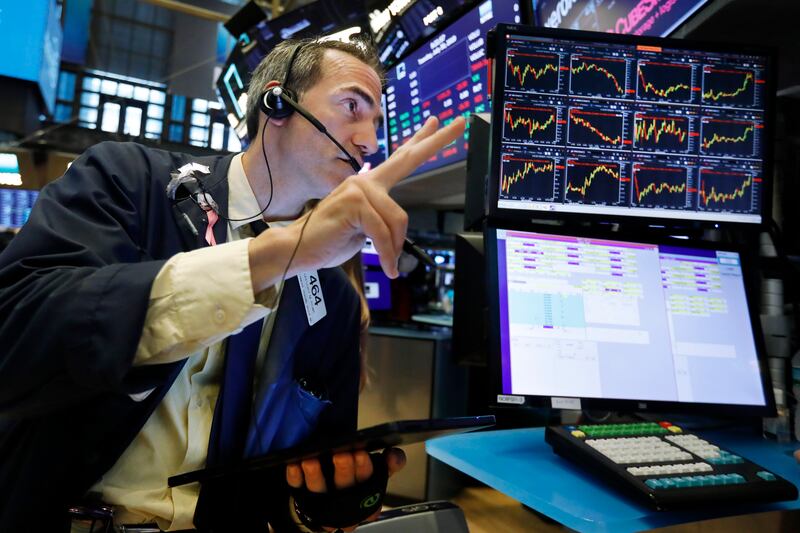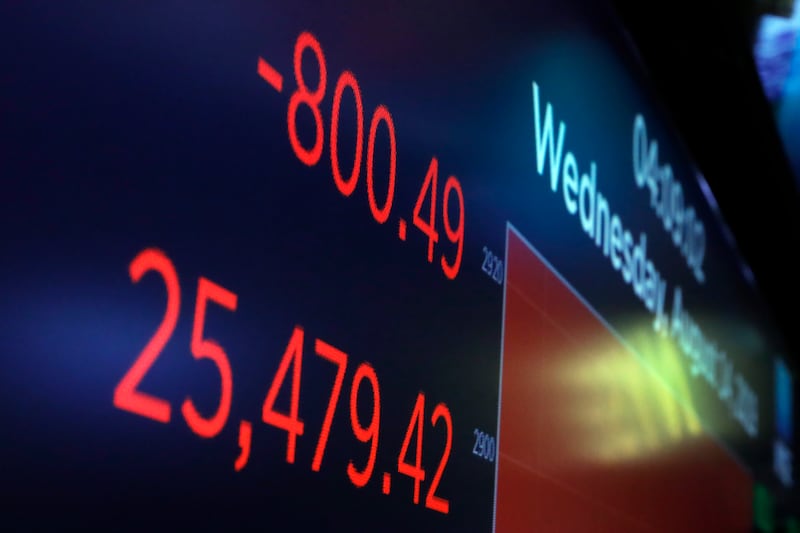SALT LAKE CITY — Predictions of a looming recession are growing, driven by a combination of natural economic cycles and political posturing leading into the 2020 presidential campaign.
Are we headed toward recession? Depends on who you ask.
The president dismissed concerns Sunday. “I don’t think we’re having a recession,” CBS News reported. “We’re doing tremendously well. Our consumers are rich. I gave a tremendous tax cut and they’re loaded up with money.”
A strong economy is key to the Republican president’s 2020 reelection prospects and Trump said negative-economy talk is designed to weaken his re-election bid. He points to the strength of the U.S. economy and extremely low unemployment, as well as a recent interest rate cut, something typically used to stimulate the economy.
Others, including potential challengers for the presidency and their supporters, have warned that the combination of trade tariffs against China, Mexico and other countries, as well as the size of the U.S. deficit, predicts a souring economy.

According to The New York Times, “Global growth has been slowing. Last week, stock markets plunged as the yield on the 10-year Treasury note briefly fell below that of the 2-year Treasury note, an unusual situation known as an inversion of the yield curve that is considered one of the most reliable leading indicators of recession in the United States.”
The definition of a recession is pretty mundane, given the fear it strikes in the minds of those who saw homes, jobs and retirement funds vanish during the Great Recession a decade ago. An economy is in a recession if, for two consecutive quarters, the GDP falls as a result of less production and trade. The recession that kicked off in 2007 was unusually long and painful.
Recession isn’t official until the National Bureau of Economic Research, a private-industry collection of economists, looks back and says, “Yes, that was one.”
But economists frequently speculate about the next one. And when the August 2019 National Association for Business Economics policy survey asked whether member economists expect recession by the end of 2021, the vast majority said yes. They divided nearly evenly, however, on whether it will happen in 2020 or 2021. Only 2 percent expect recession to start by year’s end.
The likelihood of a recession is apt to be part of the conversation when Federal Reserve officials meet in Jackson Hole, Wyoming, later this week. Any subsequent economic action on their part — deemed by most economic experts to be unlikely in the very near-term — could shed light on what they think. The president has been pressing for another interest rate cut.
Some experts oppose that and warn preemptive cuts remove a tool the government may need should recession occur. According to MarketWatch, “Officials want to keep a half-point cut in their back pocket in case market conditions and the economy deteriorate further.” Despite low inflation and unemployment, it said “there are signs that manufacturing activity is slowing and the farm sector is suffering ...”
Cycling through
Recessions are not uncommon. According to the Washington Center for Equitable Growth, “in a given year it would seem that there’s a little under a 1 in 4 chance that the U.S. economy will slip into a recession.”
Talk of a new recession has been circulating for years. Back in 2016, the center noted that “recessions, unfortunately, are inevitable. Even more unfortunately, economists have not been very good at figuring out when or how they will happen. But with the recovery from the Great Recession now in its eighth year, some scholars and policymakers are wondering if a recession in the United States is due to hit sometime soon — basically because the current recovery is about to die of old age.”
Again, that was three years ago.
“No one knows for sure what will happen in the markets. It is a constant calibration of reward potential versus potential for major loss. What is major loss? Everyone’s answer is different.” — Rob Isbitts, Forbes
According to Forbes, “There were 33 business cycles in the United States between 1854 and 2009 based on the National Bureau of Economic Research. The average length of a growing economy is 38.7 months or 3.2 years. The average recession lasts for 17.5 months or 1.5 years. A full business cycle on average is 4.7 years.”
The author, Cameron Keng, wrote that “The longest contraction or recession of record in the United States was the Great Depression in 1929 that lasted 43 months or 3.6 years. The second longest recession was the Great Recession that we all experienced in 2007 that lasted 18 months or 1.5 years. This was caused by the real estate bubble that was created during our longest expansion period or boom between 1991 and 2001.”
USA Today’s Janna Herron explained what happens in a recession: Jobs vanish — an average of 2.6 percent in the last 10 normal recessions, which means not counting the Great Recession. Employment in certain industries, including financial, tech, construction and media sectors shrink. Stocks “tank,” but bounce back.
“Typically, the stock market begins to fall from its peak months before the actual recession starts. It also starts to recover before the recession technically ends,” she wrote.
Diverging predictions
Is recession really looming? Getting a clear predictive picture is pretty tough.
The probably-not view of recession embraces, among other things, a new Commerce Department report on consumer spending that says Americans are buying goods and boosting the economy, indicating consumer confidence is high. Consumer spending is responsible for about 70 percent of what happens economically, according to MarketWatch.
That’s why some experts say talk of recession can trigger it. Nervous consumers stop spending.
According to NPR, the Commerce Department report “helped to temper recession warnings from the bond market, which triggered the year’s biggest sell-off on Wall Street last week. The Dow Jones Industrial Average and the S&P 500 both fell about 3 percent last Wednesday.”

By early morning trading on Monday, stocks were up by more than 1 percent.
Those who believe recession is within sight note that “the curve between 2-year and 10-year (Treasury) notes compressed to 1-1/2 basis points, the flattest since 2007,” as Reuters reported last week. It called yield curve inversion “a classic signal of a looming recession.”
Such an inversion occurred before each recession in the last half-century, the article said, with just one false signal. “Under these circumstances, companies often find it more expensive to fund their operations, and executives tend to temper or shelve investments. Consumer borrowing costs also rise and consumer spending, which accounts for more than two-thirds of U.S. economic activity, slows.” Typically, Reuters said, “the economy eventually contracts and unemployment rises.”
The New York TImes reported that “the combination of central banks that are at the outer limits of their ability to stimulate growth, and an inward turn by many countries, could make governments less effective at responding to a downturn.”
“It is potentially a self-inflicted-wound type of recession,” Tara Sinclair, a George Washington University economist, told the Times. “But how deep that gash goes depends on many other characteristics of the economy and the policy response thereafter.”
The article said recessions are not a sign of bad things happening, since that’s common, but rather occur when the shocks created by those bad things “are multiplied, in ways that reverberate worldwide. The dot-com crash was accentuated by the Sept. 11 terrorist attacks in 2001 and a rash of corporate scandals. The 2007 housing bust in the United States became a global financial crisis in 2008 only because banks worldwide took huge losses on mortgage debt.”
The Washington Post reported Monday that senior White House advisors were considering a temporary payroll tax cut to counter a “weakening economy.” The White House countered with a statement denying it.
Rob Isbitts, an investment strategist and portfolio manager, wrote in Forbes that “no one knows for sure what will happen in the markets. It is a constant calibration of reward potential versus potential for major loss. What is major loss? Everyone’s answer is different.”
He predicts, though, that “the market will continue its process of topping out. The U.S. economy will join the rest of the globe in entering a recession.”
“Still, for now, most economic signs appear solid,” according to The Associated Press. “Employers are adding jobs at a steady pace, the unemployment rate remains near a 50-year low and consumers are optimistic. U.S. retail sales figures out last Thursday showed that they jumped in July by the most in four months.”


